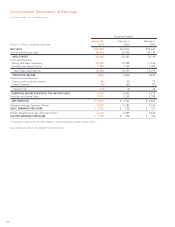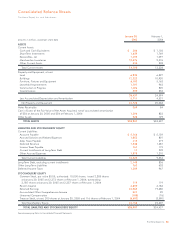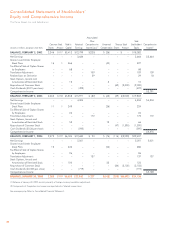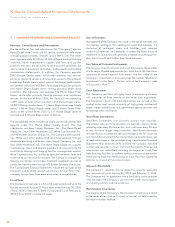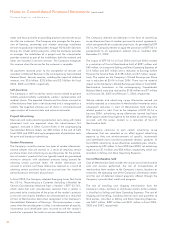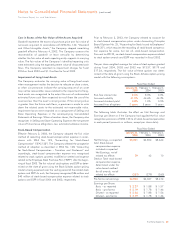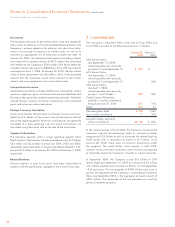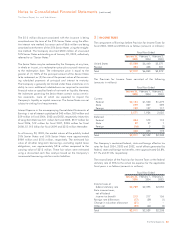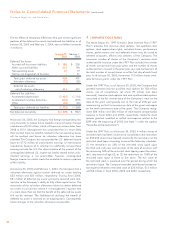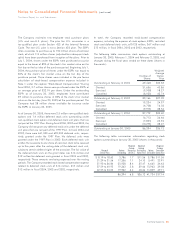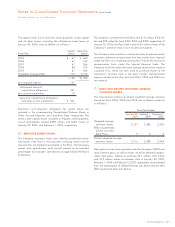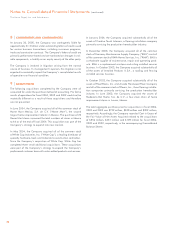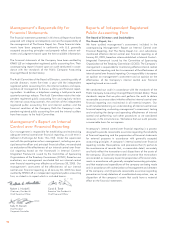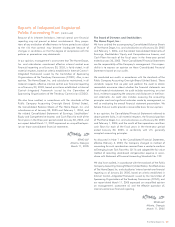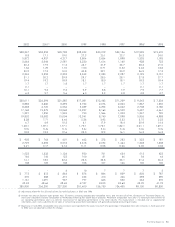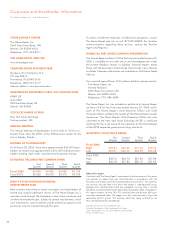Home Depot 2004 Annual Report Download - page 36
Download and view the complete annual report
Please find page 36 of the 2004 Home Depot annual report below. You can navigate through the pages in the report by either clicking on the pages listed below, or by using the keyword search tool below to find specific information within the annual report.
Notes to Consolidated Financial Statements (continued)
The Home Depot, Inc. and Subsidiaries
34
The tax effects of temporary differences that give rise to significant
portions of the deferred tax assets and deferred tax liabilities as of
January 30, 2005 and February 1, 2004, were as follows (amounts
in millions):
January 30, February 1,
2005 2004
Deferred Tax Assets:
Accrued self-insurance liabilities $185 $205
Other accrued liabilities 213 196
Net operating losses 41 19
Net loss on disposition of business –31
Total gross deferred tax assets 439 451
Valuation allowance (23) (50)
Deferred tax assets,
net of valuation allowance 416 401
Deferred Tax Liabilities:
Accelerated depreciation (1,425) (1,114)
Accelerated inventory deduction (234) (218)
Other (66) (36)
Total gross deferred tax liabilities (1,725) (1,368)
Net deferred tax liability $(1,309) $ (967)
At January 30, 2005, the Company had foreign net operating loss
carry-forwards to reduce future taxable income of certain foreign
subsidiaries of $18 million, which will expire at various dates from
2008 to 2014. Management has concluded that it is more likely
than not that these tax benefits related to the net operating losses
will be realized and hence no valuation allowance has been
provided. The Company has not provided for U.S. deferred income
taxes on $772 million of undistributed earnings of international
subsidiaries because of its intention to indefinitely reinvest these
earnings outside the U.S. The determination of the amount of the
unrecognized deferred U.S. income tax liability related to the undis-
tributed earnings is not practicable; however, unrecognized
foreign income tax credits would be available to reduce a portion
of this liability.
At January 30, 2005 and February 1, 2004, the Company had a
valuation allowance against certain deferred tax assets totaling
$23 million and $50 million, respectively. During fiscal 2004,
$31 million of deferred tax assets previously reserved were real-
ized due to the Company’s ability to fully utilize capital losses. The
remainder of the valuation allowance relates to certain deferred
tax assets in jurisdictions where it is management’s opinion that
it is more likely than not that the benefit of the deferred tax assets
will not be realized. The likelihood of realizing the benefit of
deferred tax assets is assessed on an ongoing basis. Consequently,
future changes in the valuation allowance are possible.
4|EMPLOYEE STOCK PLANS
The Home Depot, Inc. 1997 Omnibus Stock Incentive Plan (“1997
Plan”) provides that incentive stock options, non-qualified stock
options, stock appreciation rights, restricted shares, performance
shares, performance units and deferred shares may be issued to
selected associates, officers and directors of the Company. The
maximum number of shares of the Company’s common stock
authorized for issuance under the 1997 Plan includes the number
of shares carried over from prior plans and the number of shares
authorized but unissued in the prior year, plus one-half percent of
the total number of issued shares as of the first day of each fiscal
year. As of January 30, 2005, there were 113 million shares avail-
able for future grants under the 1997 Plan.
Under the 1997 Plan, as of January 30, 2005, the Company had
granted incentive and non-qualified stock options for 183 million
shares, net of cancellations (of which 99 million had been
exercised). Incentive stock options and non-qualified stock options
are priced at the fair market value of the Company’s stock on the
date of the grant and typically vest at the rate of 25% per year
commencing on the first anniversary date of the grant and expire
on the tenth anniversary date of the grant. The Company recog-
nized $86 million and $40 million of stock-based compensation
expense in fiscal 2004 and 2003, respectively, related to stock
options granted, modified or settled and expense related to the
ESPP after the beginning of 2003 (see Note 1 under the caption
“Stock-Based Compensation”).
Under the 1997 Plan, as of January 30, 2005, 4 million shares of
restricted stock had been issued net of cancellations (the restrictions
on 294,400 shares have lapsed). Generally, the restrictions on the
restricted stock lapse according to one of the following schedules:
(1) the restrictions on 25% of the restricted stock lapse upon
the third and sixth year anniversaries of the date of issuance with
the remaining 50% of the restricted stock lapsing upon the associ-
ate’s attainment of age 62, or (2) the restrictions on 100% of the
restricted stock lapse at three or five years. The fair value of
the restricted stock is expensed over the period during which the
restrictions lapse. The Company recorded stock-based compensa-
tion expense related to restricted stock of $22 million, $13 million
and $3 million in fiscal 2004, 2003 and 2002, respectively.


